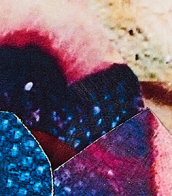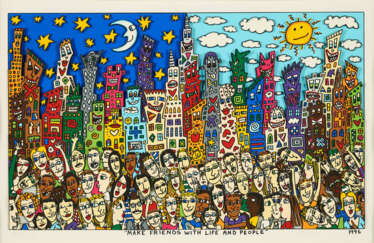friends





Cornelius Quabeck is a German abstraction artist. He often depicts humanized animals and monkeys, there are also portraits of television and music business stars - with a few strokes Quabeck puts animal ears, scars on their faces and turns them into hybrids. Kwabek also creates a series of subject photographic works.


Nathaniel Hawthorne is an American writer and author.
Hawthorne is a recognized short story writer and a master of allegorical and symbolic narrative. One of the first fiction writers in American literature, he is best known for his works The Scarlet Letter (1850) and The House of Seven Gables (1851). Hawthorne's artistic works are considered part of the American Romantic movement and, in particular, of so-called dark Romanticism, a popular mid-19th-century fascination with the irrational, the demonic, and the grotesque.


Cornelius Quabeck is a German abstraction artist. He often depicts humanized animals and monkeys, there are also portraits of television and music business stars - with a few strokes Quabeck puts animal ears, scars on their faces and turns them into hybrids. Kwabek also creates a series of subject photographic works.


James Rizzi was a renowned American artist, celebrated for his vibrant and playful Pop Art style. Born in Brooklyn, New York, Rizzi's unique approach to art combined childlike whimsy with bold, animated creations. His 3D artworks, characterized by their intricate detail and lively city scenes, set him apart in the art world.
James Rizzi's artistic journey was marked by a series of notable achievements and contributions. He gained recognition in the late 1970s and early 1980s, showcasing his works at prestigious venues like the Brooklyn Museum and creating album covers and animations for the Tom Tom Club. His style evolved into creating 3D constructions, where he meticulously sketched scenes, added vibrant colors, and transformed them into three-dimensional art pieces. This method resulted in captivating prints that exuded a sense of movement and playfulness, drawing viewers into the energetic and diverse atmosphere of New York City.
Throughout his career, James Rizzi undertook various notable projects, including designing for the Montreux Jazz Festival, the FIFA World Cup, and the Olympics. His works were not only limited to canvases but also extended to designing cars for Volkswagen and contributing to charity projects. The "Happy Rizzi House" in Braunschweig, Germany, stands as a testament to his architectural creativity.
Art enthusiasts and collectors will find James Rizzi's work particularly intriguing due to his unique process and the joyous portrayal of urban life. His art is celebrated globally, and his influence remains significant in the Pop Art movement.
If you are a collector or an expert in art and antiques, and James Rizzi's work intrigues you, sign up for updates. Stay informed about new product sales and auction events related to James Rizzi without any pompous flair. Just the essential information, directly to your inbox.


James Rizzi was a renowned American artist, celebrated for his vibrant and playful Pop Art style. Born in Brooklyn, New York, Rizzi's unique approach to art combined childlike whimsy with bold, animated creations. His 3D artworks, characterized by their intricate detail and lively city scenes, set him apart in the art world.
James Rizzi's artistic journey was marked by a series of notable achievements and contributions. He gained recognition in the late 1970s and early 1980s, showcasing his works at prestigious venues like the Brooklyn Museum and creating album covers and animations for the Tom Tom Club. His style evolved into creating 3D constructions, where he meticulously sketched scenes, added vibrant colors, and transformed them into three-dimensional art pieces. This method resulted in captivating prints that exuded a sense of movement and playfulness, drawing viewers into the energetic and diverse atmosphere of New York City.
Throughout his career, James Rizzi undertook various notable projects, including designing for the Montreux Jazz Festival, the FIFA World Cup, and the Olympics. His works were not only limited to canvases but also extended to designing cars for Volkswagen and contributing to charity projects. The "Happy Rizzi House" in Braunschweig, Germany, stands as a testament to his architectural creativity.
Art enthusiasts and collectors will find James Rizzi's work particularly intriguing due to his unique process and the joyous portrayal of urban life. His art is celebrated globally, and his influence remains significant in the Pop Art movement.
If you are a collector or an expert in art and antiques, and James Rizzi's work intrigues you, sign up for updates. Stay informed about new product sales and auction events related to James Rizzi without any pompous flair. Just the essential information, directly to your inbox.


James Rizzi was a renowned American artist, celebrated for his vibrant and playful Pop Art style. Born in Brooklyn, New York, Rizzi's unique approach to art combined childlike whimsy with bold, animated creations. His 3D artworks, characterized by their intricate detail and lively city scenes, set him apart in the art world.
James Rizzi's artistic journey was marked by a series of notable achievements and contributions. He gained recognition in the late 1970s and early 1980s, showcasing his works at prestigious venues like the Brooklyn Museum and creating album covers and animations for the Tom Tom Club. His style evolved into creating 3D constructions, where he meticulously sketched scenes, added vibrant colors, and transformed them into three-dimensional art pieces. This method resulted in captivating prints that exuded a sense of movement and playfulness, drawing viewers into the energetic and diverse atmosphere of New York City.
Throughout his career, James Rizzi undertook various notable projects, including designing for the Montreux Jazz Festival, the FIFA World Cup, and the Olympics. His works were not only limited to canvases but also extended to designing cars for Volkswagen and contributing to charity projects. The "Happy Rizzi House" in Braunschweig, Germany, stands as a testament to his architectural creativity.
Art enthusiasts and collectors will find James Rizzi's work particularly intriguing due to his unique process and the joyous portrayal of urban life. His art is celebrated globally, and his influence remains significant in the Pop Art movement.
If you are a collector or an expert in art and antiques, and James Rizzi's work intrigues you, sign up for updates. Stay informed about new product sales and auction events related to James Rizzi without any pompous flair. Just the essential information, directly to your inbox.






Nikolay Petrovich Bogdanov-Belsky (Russian: Николай Петрович Богданов-Бельский) was a renowned Russian artist, celebrated for his genre paintings depicting the education of peasant children, as well as portraits and impressionistic landscapes. Born in 1868 in Shitiki, Smolensk Governorate, Bogdanov-Belsky added "Belsky" to his surname from the district where he was born. His academic journey in art began at the Semyon Rachinsky fine art school, followed by studies at the Moscow School of Painting, Sculpture and Architecture, and later at the Imperial Academy of Arts in St. Petersburg.
Throughout his career, Bogdanov-Belsky was an active participant in Russian artistic circles, becoming a member of the Peredvizhniki from 1895 and the Arkhip Kuindzhi Society from 1909. His works often centered around the themes of rural education and childhood, capturing the subtle interplay of light and shadow and the innocence of his subjects. Notable works include "Mental Arithmetic, in the Rachinsky School" (1895) and "Sunday reading in a village school" (1895), which reflect his deep engagement with the theme of education.
After the Soviet Union came into power, the political climate and the disfavor towards realism compelled him to move to Riga, Latvia in 1921, where he continued his artistic endeavors until his death in Berlin in 1945 due to an Allied bombing during World War II.
For collectors and enthusiasts of Russian art, Bogdanov-Belsky's works offer a poignant glimpse into pre-Soviet Russian culture and education. His paintings are not only aesthetically pleasing but also historically significant, capturing the essence of a bygone era. To stay updated on sales and auction events featuring works by Nikolay Petrovich Bogdanov-Belsky, consider signing up for updates. This subscription will ensure you are informed about new opportunities to acquire pieces by this illustrious artist.


Ilya Iosifovich Kabakov (Russian: Илья́ Ио́сифович Кабако́в) was a seminal Russian-American conceptual artist, celebrated for his profound contributions to the art world, particularly through installations that critically examined Soviet life and the broader themes of human existence. Born on September 30, 1933, in Dnipropetrovsk, Ukrainian SSR, Kabakov's early life during the tumultuous World War II era and subsequent education at the V.I. Surikov State Art Institute in Moscow shaped his perspective and artistic expression. His nuanced critiques of the Soviet regime, combined with his exploration of utopian projects—including capitalism—through his art, positioned him as a pivotal figure in the dialogue between Eastern and Western artistic traditions.
Kabakov's partnership with Emilia Kanevsky, who later became his wife, led to a dynamic collaboration that spanned decades, producing influential exhibitions globally, including notable showcases at the Documenta in 1992, the Venice Biennale in 1993, and the Tate Modern in 2017. Their work is characterized by the use of fictional narratives, which often drew upon Kabakov's personal experiences to explore the life cycle of the Soviet Union, positioning it not merely as a failed socialist experiment but as one among many utopian visions susceptible to the authoritarian will to power.
Throughout his career, Kabakov never shied away from the complexity of the human condition, as evidenced by his installations like "The Man Who Flew Into Space From His Apartment" and "The Toilet," which resonate with viewers for their depth and the universality of their themes. His artworks are part of the collections of prestigious institutions such as the Museum of Modern Art, the Centre Pompidou, and the State Hermitage Museum, underscoring his significant impact and enduring legacy in the art world.
Kabakov's death on May 27, 2023, at the age of 89, marked the end of a prolific career that left an indelible mark on the landscape of conceptual art. His work continues to inspire and provoke thought, bridging the gap between personal narrative and global history, and inviting viewers to reconsider their perspectives on society, history, and the role of art in reflecting and shaping human experience.
For collectors and experts in art and antiques interested in staying updated on exhibitions and auctions related to Ilya Iosifovich Kabakov, signing up for updates can provide exclusive insights and opportunities to engage with his impactful body of work. This subscription ensures that enthusiasts are well-informed about new sales and events, allowing them to deepen their appreciation for Kabakov's artistic contributions.










































































